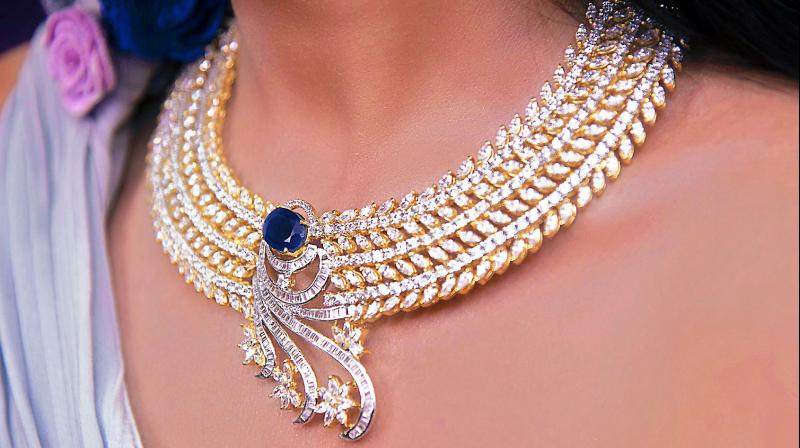Diamonds that trick

Malini Aiyer bought a diamond-studded necklace as part of her daughter’s bridal trousseau two years ago. Her family jeweller had made it at 20 per cent lesser than the cost of a similar one at the leading jewellery stores in the city. But when her daughter Anupama moved to a new city last month, and wanted to sell it as she needed cash, the jewellery store insisted on getting the diamonds certified before buying it from her. On checking, they discovered that one-third of the stones in the piece were man-made, synthetic diamonds.
All that glitters may not necessarily be a diamond. Especially if it’s not certified, as we learn about the rampant mixing of synthetic, lab-grown diamonds with real ones.
Malini was shocked. When her mom questioned the family jeweller, he put the blame on the supplier of loose diamonds and confessed that he too cannot distinguish between lab-grown and real diamonds!
Tehmasp Printer, managing director of International Gemological Institution (IGI) India, agrees that even jewellers cannot differentiate between synthetic and earth-mined diamonds. “You need equipment for that and only gemological labs can guarantee real diamonds. With real diamonds, skilled jewellers can easily distinguish fake from real ones. But that is not the case with synthetics,” says Tehmasp.
Not all diamonds are certified
Despite India having several gemological labs across different cities, not all the diamond-studded jewellery sold in the market is certified. Organised jewellers, however, ensure that all the diamonds sold by them are duly certified. But in a country where customers still trust their small-time family jeweller for their jewellery purchases, there’s a threat of man-made diamonds, which look more attractive cost-wise as they come 50 to 60 per cent cheaper than the real ones, being used. Ironically, the jeweller may not be doing it intentionally. Like the consumer, he, too, is being tricked.
Currently, no jeweller in India officially sells synthetic jewellery, but import of both rough and polished synthetic diamonds are increasing significantly. That being said, there are a few units in Surat producing lab-grown diamonds.
In the financial year 2019 (FY19), India imported Rs 1,960 crore-worth synthetic diamonds Rs 1,067-crore-worth rough synthetics and Rs 8,93 crore-worth polished synthetics. As per data from Gems and Jewellery Export Promotion Council, we exported Rs 1,582-crore-worth polished synthetic diamonds in FY19. “The chances that imported and locally produced synthetics getting mixed with real ones are high,” cautions Pankaj Parekh, former vice-chairman of Gems and Jewellery Export Promotion Council.
In fact, Tehmasp claims that mixing of synthetics with real loose diamonds is happening. “Synthetic diamonds are often detected among real diamond parcels sent by jewellers,” he adds.
The synthetic tale
Incidentally, even De Beers accepted that synthetic diamonds are available in the market. Perhaps to counter it or to ride the wave, a few months ago, they launched their ‘Lightbox Jewellery’, a brand for synthetic diamond jewellery, making it a separate category. But in India, synthetics are still passed off as real, affecting the credibility of the diamond industry in the export and domestic markets. The Indian government is working on making necessary changes to Consumer Protection Act 1986 to distinguish between synthetic diamonds and natural diamonds.
Last year, the Kimberley Process Plenary,a coalition of governments, civil society and the diamond industry, had adopted the Administrative Decision on using Unified Diamond Nomenclature and Terminology as a best practice as per the industry’s Diamond Terminology Guidelines.
This was intended to address the concerns of the diamond industry and to give the Kimberley Process participants as much information on the concerns and best practices that exist in the industry today.
The way forward
Consumers can, meanwhile, secure their investments in real diamonds by insisting on certification. Similar to hallmarking in gold, certification of diamonds, too, has to become the norm. Once the consumer is aware of this and insists on getting every diamond certified, the mixing trend will die out on its own.
But is certification a costly process? “No. In fact, the cost is minimal as compared to the loss that buying a synthetic diamond for the price of real can bring. The organised jewellers absorb the cost of certification. If a jeweller discourages the customer from getting the diamonds certified citing the cost factor, that’s definitely a red flag,” Tehmasp adds.
Incidentally, IGI has set up labs in 17 cities across Indian and claims it can cater to the current demand for certification. GIA, AGS and EGL are some of the other certification agencies.
Very difficult to spot the difference
It’s almost impossible for a jeweller to be able spot the difference between a lab-grown and a natural diamond by just looking at it. You need to understand the formation of the diamond and that requires chemical analysis which OGI, IGI, and such laboratories do and they issue a certificate saying whether it’s a natural diamond or a lab-grown diamond.
Consumers must ask for a certificate that says these are the natural diamonds that have been used. Otherwise, there is no other way of checking. The reality is that synthetic diamonds have existed for quite some time and a lot of gullible clients have been actually buying them.
Technically, the bigger size diamonds, which is one single solitaire, is easier and economical to get a certificate for. The value of the smaller diamonds where they use like 1,000 diamonds in a set, the cost of certification is very high — as each stone has to be checked. That’s where the mixing can happen.
— Darshan Dave, Diosa Jewels
Buy only from reputed jewellers
I haven’t come across as any such case where the buyer has asked for a real diamond but has got a lab-made diamond. Maybe that’s a concern. There are two things – people who are selling these lab-grown diamonds are not lying about it. So there are these brands that are dealing with lab-grown diamonds but they are coming clean about it and that’s why they are cheap in price.
As reputed jewellers, when we buy our diamonds, we get our diamonds tested. So even if it’s coming from regular sources, we always have every lot tested. We make sure that it’s natural and not lab-grown, in fact, now we are in the process of procuring a machine, which will identify the lab-grown diamond even in the jewellery. Also, I feel, one of the ways that the consumers can protect themselves is by buying from reputed jewellers. They should not buy from people who are working from home, are unorganised.
— Ishu Datwani,
founder of the Anmol Jewellers

